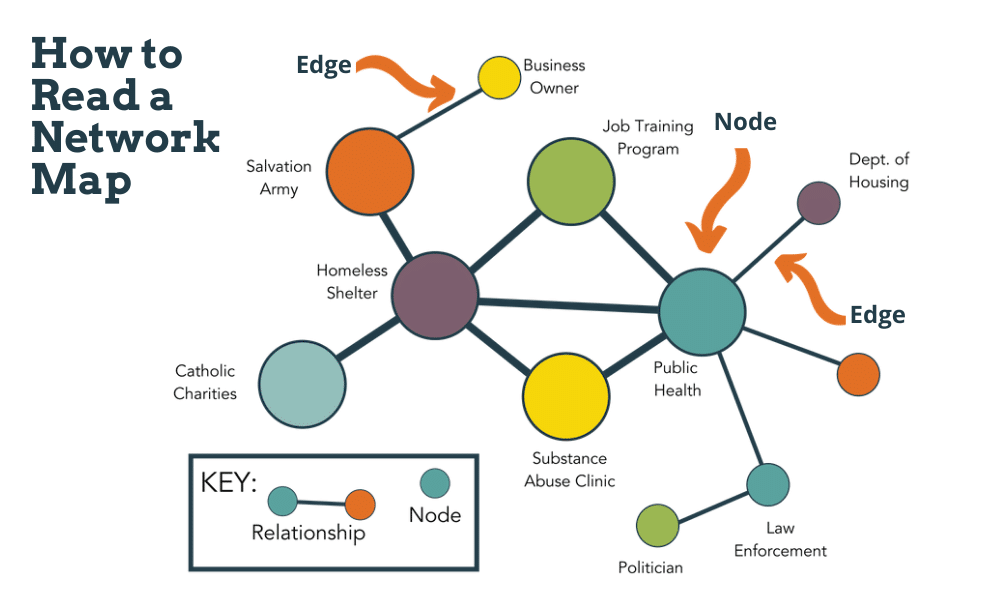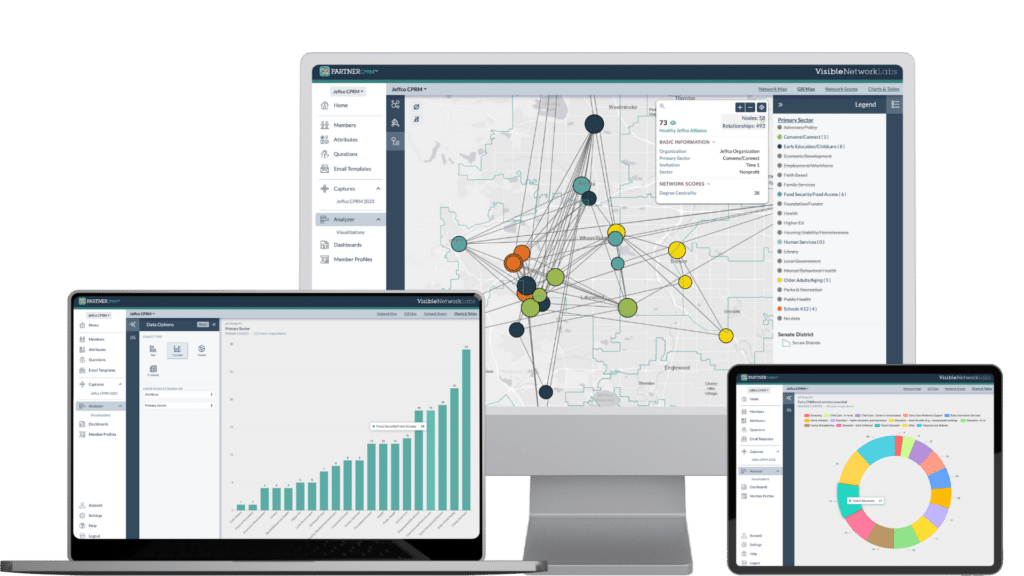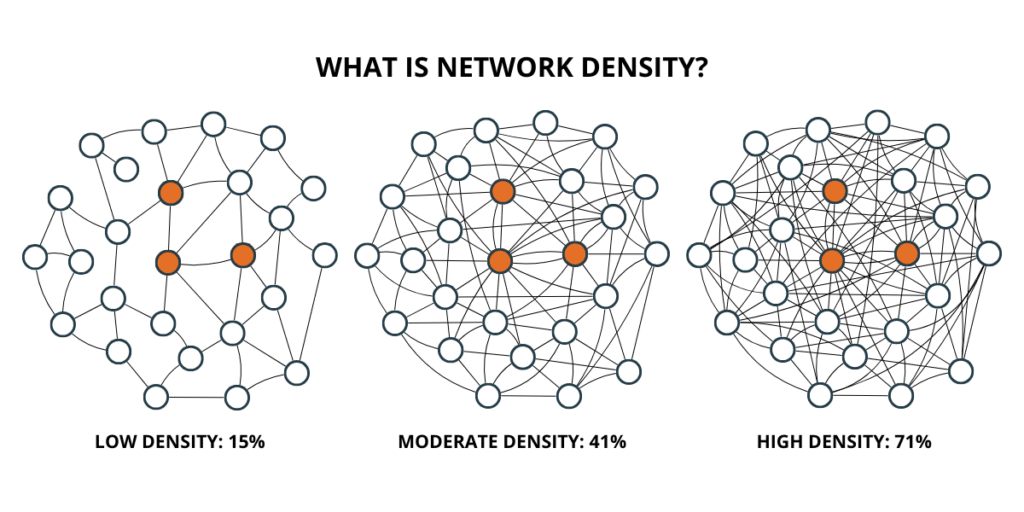Network density is a powerful measure in social network analysis that reveals the level of connection between members within a network. By understanding network density, organizations can assess how deeply and broadly members are collaborating, which can provide insight into both strengths and gaps in the network’s collaborative structure. High or low density in a network often leads to different strategic choices, guiding organizations toward a balanced, effective, and sustainable collaboration environment.
This article explores how to assess network density to gauge the overall intensity of collaboration, helping organizations determine whether their network structure is aligned with their goals or if strategic relationship-building is needed to boost connectivity and trust.
Table of Contents
What is Network Density?
Network density measures the ratio of actual connections (or ties) in a network to the total possible connections. In other words, it tells you how interconnected the members of a network are relative to the maximum level of connection they could achieve. Density is expressed as a percentage, with 100% indicating a fully connected network where each member is directly connected to every other member.
In practice:
- High density suggests a closely-knit network where members are well-connected, potentially leading to strong collaboration and faster information flow.
- Low density indicates fewer connections between members, which can imply a more fragmented network with potential barriers to communication and collaboration.

Why Density Matters for Collaboration
Network density is a valuable tool for evaluating how collaborative or fragmented a network is. While intuitively, one might assume that higher density is always better, this is not necessarily the case. Both high and low density have their own advantages and limitations, and the ideal density for any network depends on the goals of the organization.
High Density: In a high-density network, information flows quickly, and collaboration is generally strong. However, high density can also lead to redundancies, with members being overwhelmed by too many connections or too much information. Over time, this can lead to inefficiency and “collaboration fatigue.”
Low Density: In a low-density network, members have fewer redundant connections, potentially leading to more independence and less pressure to constantly engage. However, if the density is too low, members might struggle to collaborate effectively, as communication pathways are fewer, and members may feel isolated.
By analyzing density, organizations can determine if their network is balanced to promote effective collaboration without overwhelming members or leaving them disconnected.
How to Measure Network Density
To measure network density, you’ll need to start by gathering data on the relationships within your network. The PARTNER CPRM platform simplifies this process by automatically calculating network density once you’ve mapped relationships among members. Here’s a basic formula for understanding how density is calculated:
Density = (Number of actual connections) / (Number of possible connections)
Identify Total Connections: Count the number of existing ties or connections in the network.
Calculate Possible Connections: For a network with nnn members, the total possible connections is n(n−1)/2n(n – 1) / 2n(n−1)/2.
Calculate Density: Divide the actual connections by the possible connections and multiply by 100 to express it as a percentage.
In the PARTNER CPRM platform, this process is automated, providing you with a density metric you can analyze directly on the network analyzer.

Get our monthly newsletter with resources for cross-sector collaboration, VNL recommended reading, and upcoming opportunities for engaged in the “network way of working.”
Interpreting Density in Your Network
Understanding network density alone is a good start, but its real value comes when you interpret this measure in light of your organization’s goals and collaboration needs. Here’s how density levels can inform strategic insights:
High Density (over 50%): If your network density is high, members are well-connected, which can be ideal for organizations needing rapid information dissemination or where trust and consensus are crucial. However, a density above 70% might suggest redundancy, which could lead to collaboration overload. In such cases, consider whether any roles or connections could be streamlined to reduce pressure on network members while maintaining effective collaboration.
Moderate Density (20-50%): A moderate density often reflects a balanced network where collaboration happens without overwhelming members. This level can be beneficial for organizations aiming for targeted collaboration without forcing connections that aren’t essential. A density in this range often indicates that the network has room to grow connections selectively as needed, focusing on adding high-value ties.
Low Density (under 20%): Low density may be suitable for networks where independence is prioritized, or where members act more as independent agents. However, if effective collaboration is a goal, a low-density network could indicate a need to increase connections to strengthen overall network cohesiveness. In this case, focus on identifying and connecting key members or sub-groups that could bridge disconnected parts of the network.
Remember, all networks are unique. The ideal level of density depends on your community context, network goals, and other variables specific to you and your partners. Always take that into account during your analysis.

Strategic Steps to Optimize Density for Effective Collaboration
Once you’ve measured and interpreted your network’s density, the next step is to act on those insights to improve network health and align with strategic goals. Here are some practical strategies:
Strengthen Core Connections: If your network density is low, focus on building relationships between central or highly connected nodes and those on the periphery. This can enhance connectivity without significantly increasing the overall network density.
Encourage High-Value Connections: For networks that are already dense, focus on building high-value or high-trust connections instead of simply adding more ties. Encourage members to engage in meaningful, collaborative interactions that reinforce trust and mutual support.
Reduce Redundant Connections: If your network is highly dense, consider whether some connections may be redundant. Reducing these connections can relieve “collaboration overload” and ensure that the most essential partnerships remain strong and productive.
Create Clusters or Working Groups: When density is high, creating sub-groups or clusters can focus collaboration efforts, making it easier for members to connect meaningfully without being overwhelmed by too many ties.
Monitor Changes Over Time: Network density isn’t static; as members leave or join and projects evolve, density levels can shift. Regularly monitor density to track changes and adjust your network strategy as needed.

Why Choose PARTNER CPRM for Network Density Analysis?
The PARTNER CPRM platform offers powerful, easy-to-use tools for measuring network density, providing valuable insights into the connectivity and collaboration dynamics within your network. By visualizing and analyzing density, PARTNER CPRM enables you to identify areas where relationships may need strengthening, detect over-connected areas at risk of collaboration fatigue, and ensure your network structure aligns with your goals.
With intuitive visualizations and automated metrics, PARTNER CPRM makes it simple to monitor your network health over time and act strategically to optimize connectivity.
Ready to see the power of network density analysis firsthand? Request a demo or get started for free with PARTNER CPRM today!
Conclusion
Network density is a vital metric for organizations seeking to optimize collaboration and build a well-functioning, resilient network. By analyzing density, organizations can determine whether their network structure supports effective collaboration or if strategic adjustments are necessary to maintain a healthy balance of connectivity and independence.
Whether your network is highly connected or more loosely organized, understanding and managing density allows you to foster a collaborative environment that supports your mission, minimizes redundancy, and maximizes member engagement. Use the PARTNER CPRM platform’s network density insights to keep your network balanced, focused, and ready to meet your organization’s goals.
FAQs
Q: What is Network Density?
A: Network density is a measure of how connected a network is. It represents the ratio of actual connections (or ties) in a network to the total possible connections if every node were connected to every other node. It’s expressed as a percentage, with higher values indicating more interconnectedness.
Q: How is network density calculated?
A: Network density is calculated by dividing the number of actual connections by the number of possible connections, then multiplying by 100 to express it as a percentage.
For a network with “n” nodes, you can find the total possible connections by using this formula:
- Multiply the number of nodes (“n”) by “n minus 1,” then divide by 2.
Once you have the total possible connections, calculate density as:
- Divide the number of actual connections by the total possible connections, then multiply by 100 to get the density as a percentage.
Q: What does a high network density indicate?
A: High network density means that most nodes in the network are well-connected. This can lead to strong collaboration, faster information flow, and increased trust among network members. However, it may also result in redundancy or “collaboration overload” if members feel overwhelmed by too many connections.
Q: What does a low network density indicate?
A: Low density suggests that the network has relatively few connections among members, which can indicate more independence. While this structure can reduce redundancy, it may also hinder collaboration and information flow, potentially leading to inefficiencies if the network’s goals require high connectivity.
Q: Is higher network density always better?
A: Not necessarily. While high density can mean better collaboration, it can also lead to inefficiency if there are too many redundant connections. The ideal density depends on the network’s goals; sometimes, a moderate density level is more sustainable and effective for achieving specific outcomes.
Q: How can we increase network density?
A: To increase network density, you can encourage new connections between members who aren’t yet connected. This might involve hosting networking events, fostering cross-functional collaboration, or strategically connecting key individuals or groups to enhance overall connectivity.
Q: How can we decrease network density if it’s too high?
A: If density is too high, try reducing redundant or non-essential connections. Encourage members to focus on high-value relationships, organize sub-groups to manage engagement, or clarify roles to avoid overwhelming members with too many interactions.
Q: How does network density impact network resilience?
A: High-density networks are often more resilient because multiple connections allow information and resources to flow even if some connections are lost. In low-density networks, the loss of a few key connections can have a larger impact, making the network more vulnerable to disruption.
Q: Can network density change over time?
A: Yes, network density can fluctuate as members join or leave and as relationships evolve. Regularly monitoring density helps track these changes and allows for adjustments to support network health and strategic goals over time.
Q: How often should network density be assessed?
A: The frequency depends on the network’s dynamics and objectives. For fast-changing networks, consider assessing density quarterly or monthly. For more stable networks, periodic annual reviews are sufficient to ensure alignment with strategic goals.







